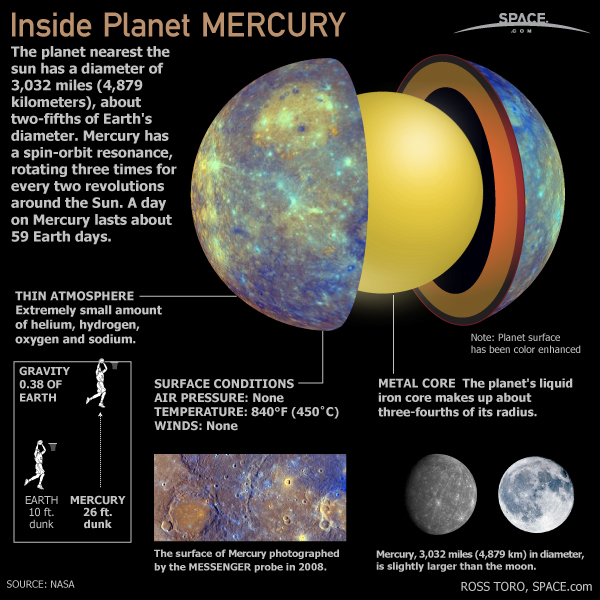Inside Planet Mercury (Infographic)

Mercury is the closest planet to the Sun in Earth’s solar system, but has no moons and no substantial atmosphere. Mercury is named after the Roman swift-footed messenger God.
As the planet nearest the sun, the surface of Mercury can reach a scorching 840 degrees F (450 degrees C). However, since this world doesn't have a real atmosphere to entrap any heat, at night temperatures can plummet to minus 275 degrees F (minus 170 degrees C), a more than 1,100 degrees F (600 degree C) temperature swing that is the greatest in the solar system.
Mercury is the smallest planet — it is only slightly larger than Earth's moon. Since it has no significant atmosphere to stop impacts, the planet is pockmarked with craters. For instance, about 4 billion years ago, a roughly 60-mile-wide (100-kilometer-wide) asteroid struck Mercury with an impact equal to 1 trillion 1-megaton bombs, creating a vast impact crater roughly 960 miles (1,550 kilometers) wide. Known as the Caloris Basin, this crater could hold the entire state of Texas.
NASA's $446 million Messenger probe (which stands for MErcury Surface, Space ENvironment, GEochemistry, and Ranging) was launched in 2004 and has been in orbit around Mercury since 2011.
Messenger's Latest Views of Mercury
Planet Mercury: Simple Facts, Tough Quiz
Messenger Captures a Spinning Map of Mercury
Breaking space news, the latest updates on rocket launches, skywatching events and more!

Karl's association with Space.com goes back to 2000, when he was hired to produce interactive Flash graphics. From 2010 to 2016, Karl worked as an infographics specialist across all editorial properties of Purch (formerly known as TechMediaNetwork). Before joining Space.com, Karl spent 11 years at the New York headquarters of The Associated Press, creating news graphics for use around the world in newspapers and on the web. He has a degree in graphic design from Louisiana State University and now works as a freelance graphic designer in New York City.
